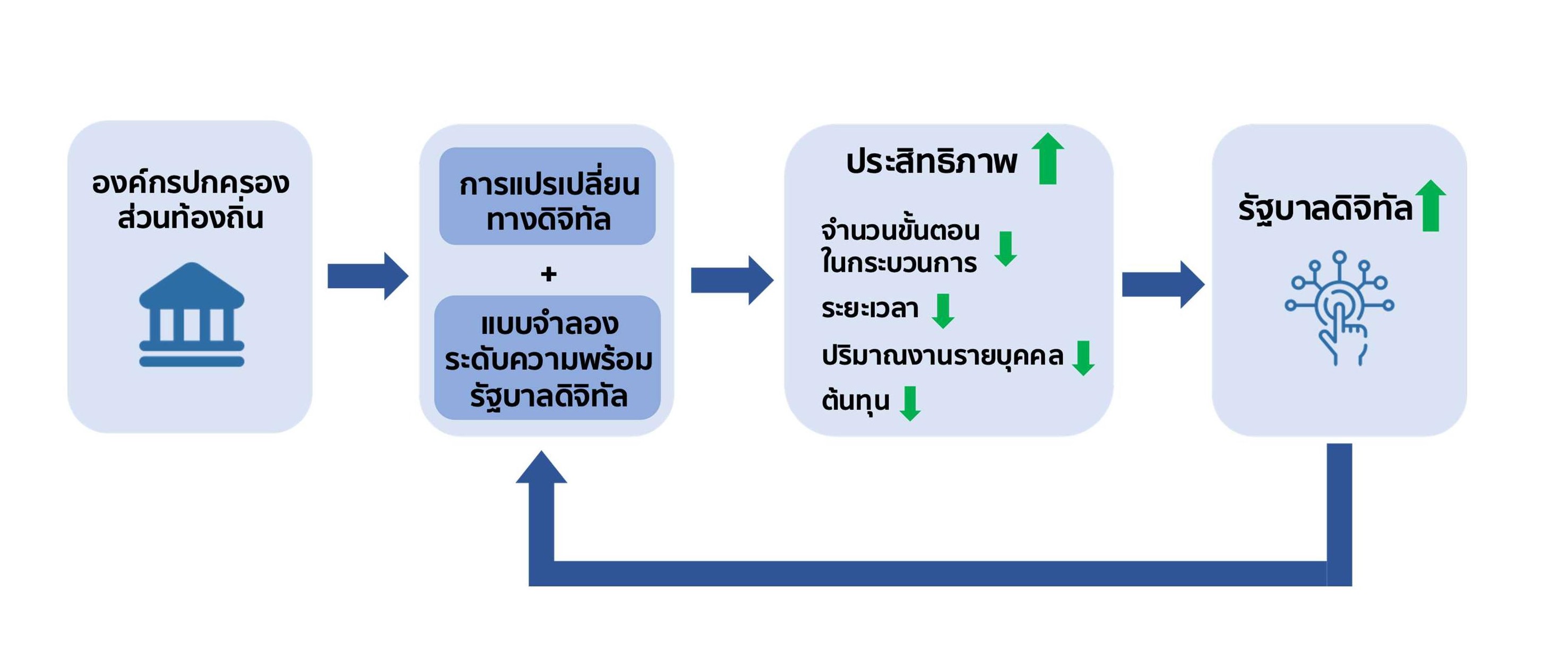Analysis of Processes for Evaluating the Efficiency of Digital Public Services: A Case Study of Non Sa-at Subdistrict Municipality, Nong Bua Lamphu Province
Main Article Content
Abstract
The purposes of this research were 1) examine and evaluate assess the efficiency of work processes before and after the implementation of integration of digital technologies, and 2) propose strategies for enhancing the digital governance maturity of the Non Sa-at Sub district Municipality, Sri Bun Rueang District, Nong Bua Lamphu Province. This research utilized an exploratory approach, gathering primary data through group interviews with stakeholders from four key sectors: public services, education, procurement, and health. Additionally, secondary data was sourced from system database usage logs. Utilizing a survey research methodology, primary data was collected from officer staffs involved in four key areas: public services, education, procurement, and health, through focus group interviews. Secondary data was gathered from system database usage logs. Content analysis was used for primary data, while ETL procedures were applied to secondary data. The synthesized results were represented in cross-functional diagrams and supported by descriptive statistics. The results were synthesized into cross-functional diagram and complemented by descriptive statistics, including maximum, minimum, frequency, average, and percentage values, to determine the efficiency of each process.
The major findings revealed as follows:
1. The integration of digital technology, namely "Non Sa-at Innovation," significantly enhanced public service efficiency. The Non Sa-at Sub district Municipality's integration of digital technologies, termed 'Non Sa-at Innovation,' significantly enhanced the efficiency of public service delivery. The efficiency of process steps increased by 394.4%, while the time efficiency improved by 515%, while the. Additionally, the average workload per individual person and the associated costs became reduced more efficient by 165.6% and 656.4%, respectively. Bottlenecks were primarily identified in at the assistant clerical officer level, particularly in processes positions responsible for at both departmental and central levels, where document tracking and transfer forwarding were pivotal documents. These issues were addressed by the application of employing digital technology and digital by design concepts to further streamline optimize processes.
2. To elevate to further advance a higher level of digital governance, it is recommended to expand these improvements to other remaining processes within the organization. The substitution of electronic documents for paper, coupled with the promotion of digital, data, and cyber security literacy among staff and citizens, is advisable. This approach aims to ensure a sustainable transition to more comprehensive digital governance.
Article Details

This work is licensed under a Creative Commons Attribution-NonCommercial-NoDerivatives 4.0 International License.
เพื่อให้เป็นไปตามกฎหมายลิขสิทธิ์ ผู้นิพนธ์ทุกท่านต้องลงลายมือชื่อในแบบฟอร์มใบมอบลิขสิทธิ์บทความ ให้แก่วารสารฯ พร้อมกับบทความต้นฉบับที่ได้แก้ไขครั้งสุดท้าย นอกจากนี้ ผู้นิพนธ์ทุกท่านต้องยืนยันว่าบทความ ต้นฉบับที่ส่งมาตีพิมพ์นั้น ได้ส่งมาตีพิมพ์เฉพาะในวารสาร วิชาการธรรม ทรรศน์ เพียงแห่งเดียวเท่านั้น หากมีการใช้ ภาพหรือตารางของผู้นิพนธ์อื่นที่ปรากฏในสิ่งตีพิมพ์อื่นมาแล้ว ผู้นิพนธ์ต้องขออนุญาตเจ้าของลิขสิทธิ์ก่อน พร้อมทั้ง แสดงหนังสือที่ได้รับการยินยอมต่อบรรณาธิการ ก่อนที่บทความจะได้รับการตีพิมพ์References
กฤษดา ประชุมราศี. (2565). การประเมินการตอบสนองของการประยุกต์ใช้เครื่องมือดิจิทัลในการรับเรื่องร้องทุกข์ขององค์กรปกครองส่วนท้องถิ่น: กรณีศึกษา เทศบาลนครขอนแก่น. วารสาร มจร สังคมศาสตร์ปริทรรศน์, 11(5), 363-373.
ณัฏฐวีร์ อินทรเกษม, ยุรพร ศุทธรัตน์ และพิทวัส เอื้อสังคมเศรษฐ์. (2561). การนำ Swim Lane Diagram มาใช้ในการปรับปรุงกระบวนการทางธุรกิจ. วารสารสถาบันเทคโนโลยีไทย-ญี่ปุ่น: บริหารธุรกิจและภาษา, 6(2), 52-57.
บุรเทพ โชคธนานุกูล. (2565). อิทธิพลของประสิทธิภาพการให้บริการสาธารณะที่มีต่อปัจจัยพฤติกรรมองค์การของบุคลากรทางการแพทย์ สำนักการแพทย์กรุงเทพมหานคร. วารสารการจัดการสมัยใหม่, 20(2), 102-115.
บูรณจิตร แก้วศรีมล. (2565). การให้บริการสาธารณะภายใต้แนวคิดรัฐบาลดิจิทัล. วารสารมนุษยศาสตร์และสังคมศาสตร์ มหาวิทยาลัยมหาสารคาม, 41(5), 84-97.
ปิยะ กล้าประเสริฐ. (2559). การประเมินประสิทธิภาพการให้บริการสาธารณะขององค์กรปกครองส่วนท้องถิ่น จังหวัดปทุมธานี. วารสารวิจัยและพัฒนาวไลยอลงกรณ์ ในพระบรมราชูปถัมภ์ สาขามนุษยศาสตร์และสังคมศาสตร์, 11(2), 215-227.
วุฒิสาร ตันไชย. (2557). การกระจายอำนาจและประชาธิปไตยในประเทศไทย. (พิมพ์ครั้งที่ 2). กรุงเทพฯ: สถาบันพระปกเกล้า.
สำนักงานคณะกรรมการข้าราชการพลเรือน. (2562). แบบสำรวจระดับความพร้อมและวุฒิภาวะขององค์กรในการพัฒนาไปสู่รัฐบาลดิจิทัล. เข้าถึงได้จาก https://www.ocsc.go.th/digital_hr/mda
สำนักงานพัฒนาธุรกรรมทางอิเล็กทรอนิกส์. (2563). พ.ร.บ.ธุรกรรมฯ เดอะซีรีส์. เข้าถึงได้จาก https://www.etda.or.th/th/Useful-Resource/Knowledge-Sharing/Electronic-Transactions-Act-the-Series_Ep1.aspx
สำนักงานพัฒนารัฐบาลดิจิทัล (องค์การมหาชน). (2566). ผลสำรวจระดับความพร้อมรัฐบาลดิจิทัลหน่วยงานภาครัฐของประเทศไทย ประจำปี 2566. เข้าถึงได้จาก https://www.dga.or.th/policy-standard/policy-regulation/dg-readiness-survey/readinesssurvey66/101173/
สุขุม รัตนเสรีเกียรติ. (2563). ประสิทธิภาพ และประสิทธิผล (Efficiency VS Effectiveness). เข้าถึงได้จาก https://www.tpa.or.th/writer/read_this_book_topic.php?bookID=4744
Bal, J. (1998). Process analysis tools for process improvement. The TQM Magazine, 10(5), 342-354.
Bansal, S. K., & Kagemann, S. (2015). Integrating Big Data: A Semantic Extract-Transform-Load Framework. Computer, 48(3), 42-50.
Danaher, P. J., & Mattsson, J. (1998). A comparison of service delivery processes of different complexity. International Journal of Service Industry Management, 9(1), 48-63.
Kemp, S. (2023). Digital 2023: Thailand. Retrieved from https://datareportal. com/reports/digital-2023-thailand
Kraus, S., et al. (2021). Digital Transformation: An Overview of the Current State of the Art of Research. SAGE Open, 11(3), 1-15.
Larsson, A., & Teigland, R. (2019). Digital Transformation and Public Services: Societal Impacts in Sweden and Beyond. New York: Taylor & Francis.
Marchionini, G., Samet, H., & Brandt, L. (2003). Digital Government. Communications of the ACM, 46(1), 24-27.
Mihaiu, D. M., Opreana, A., & Cristescu, M. P. (2010). Efficiency, Effectiveness and Performance of the Public Sector. Romanian Journal of Economic Forecasting, 4(1), 132-147.
Milakovich, M. E. (2022). Digital governance: Applying advanced technologies to improve public service. (2nd ed.). New York: Taylor & Francis.
Organisation for Economic Co-operation and Development (OECD). (2014). OECD Recommendation on Digital Government Strategies. Retrieved from https://www.oecd.org/gov/digital-government/recommendation-on-digital-government-strategies.htm
Rummler, G. A., & Brache, A. P. (2012). Improving performance: How to manage the white space on the organization chart. (3rd ed.). New York: John Wiley & Sons.
Ubaldi, B., & Okubo, T. (2020). OECD Digital Government Index (DGI): Methodology and 2019 results. Retrieved from https://doi.org/10.1787/b00142a4-en
Vassiliadis, P., Simitsis, A., & Baikousi, E. (2009). A taxonomy of ETL activities. In Proceedings of the ACM twelfth international workshop on Data warehousing and OLAP, November 6, 2009, (Pages 25-32). New York: Association for Computing Machinery.
Worthington, A. C., & Dollery, B. E. (2001). Measuring Efficiency in Local Government: An Analysis of New South Wales Municipalities’ Domestic Waste Management Function. Policy Studies Journal, 29(2), 232-249.

